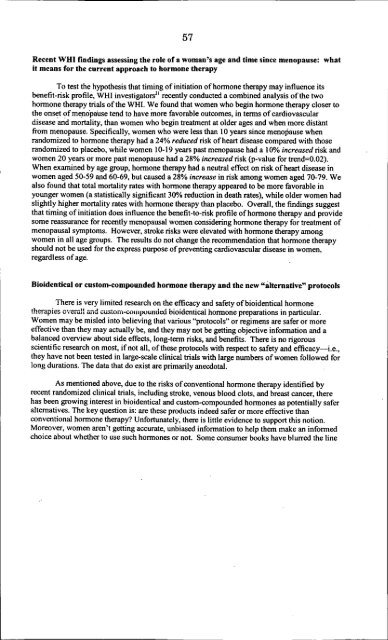Bioidentical Hormones - U.S. Senate Special Committee on Aging
Bioidentical Hormones - U.S. Senate Special Committee on Aging
Bioidentical Hormones - U.S. Senate Special Committee on Aging
You also want an ePaper? Increase the reach of your titles
YUMPU automatically turns print PDFs into web optimized ePapers that Google loves.
57<br />
Recent WHI findings assessing the role of a woman's age and time since menopause: what<br />
it means for the current approach to horm<strong>on</strong>e therapy<br />
To test the hypothesis that timing of initiati<strong>on</strong> of horm<strong>on</strong>e therapy may influence its<br />
benefit-risk profile, WHI investigators 2 ' recently c<strong>on</strong>ducted a combined analysis of the two<br />
horm<strong>on</strong>e therapy trials of the WHI. We found that women who begin horm<strong>on</strong>e therapy closer to<br />
the <strong>on</strong>set of menopause tend to have more favorable outcomes, in terms of cardiovascular<br />
disease and mortality, than women who begin treatment at older ages and when more distant<br />
from menopause. Specifically, women who were less than 10 years since menopause when<br />
randomized to horm<strong>on</strong>e therapy had a 24% reduced risk of heart disease compared with those<br />
randomized to placebo, while women 10-19 years past menopause had a 10% increased risk and<br />
women 20 years or more past menopause had a 28% increased risk (p-value for trend=0.02).<br />
When examined by age group, horm<strong>on</strong>e therapy had a neutral effect <strong>on</strong> risk of heart disease in<br />
women aged 50-59 and 60-69, but caused a 28% increase in risk am<strong>on</strong>g women aged 70-79. We<br />
also found that total mortality rates with horm<strong>on</strong>e therapy appeared to be more favorable in<br />
younger women (a statistically significant 30% reducti<strong>on</strong> in death rates), while older women had<br />
slightly higher mortality rates with horm<strong>on</strong>e therapy than placebo. Overall, the findings suggest<br />
that timing of initiati<strong>on</strong> does influence the benefit-to-risk profile of horm<strong>on</strong>e therapy and provide<br />
some reassurance for recently menopausal women c<strong>on</strong>sidering horm<strong>on</strong>e therapy for treatment of<br />
menopausal symptoms. However, stroke risks were elevated with horm<strong>on</strong>e therapy am<strong>on</strong>g<br />
women in all age groups. The results do not change the recommendati<strong>on</strong> that horm<strong>on</strong>e therapy<br />
should not be used for the express purpose of preventing cardiovascular disease in women,<br />
regardless of age.<br />
<str<strong>on</strong>g>Bioidentical</str<strong>on</strong>g> or custom-compounded horm<strong>on</strong>e therapy and the new "alternative" protocols<br />
There is very limited research <strong>on</strong> the efficacy and safety of bioidentical horm<strong>on</strong>e<br />
therapies overall and cust un-wiimpounded bioidenticai horm<strong>on</strong>e preparati<strong>on</strong>s in particular.<br />
Women may be misled into believing that various "protocols" or regimens are safer or more<br />
effective than they may actually be, and they may not be getting objective informati<strong>on</strong> and a<br />
balanced overview about side effects, l<strong>on</strong>g-term risks, and benefits. There is no rigorous<br />
scientific research <strong>on</strong> most, if not all, of these protocols with respect to safety and efficacy-i.e.,<br />
they have not been tested in large-scale clinical trials with large numbers of women followed for<br />
l<strong>on</strong>g durati<strong>on</strong>s. The data that do exist are primarily anecdotal.<br />
As menti<strong>on</strong>ed above, due to the risks of c<strong>on</strong>venti<strong>on</strong>al horm<strong>on</strong>e therapy identified by<br />
recent randomized clinical trials, including stroke, venous blood clots, and breast cancer, there<br />
has been growing interest in bioidentical and customr-compounded horm<strong>on</strong>es as potentially safer<br />
alternatives. The key questi<strong>on</strong> is: are these products indeed safer or more effective than<br />
c<strong>on</strong>venti<strong>on</strong>al horm<strong>on</strong>e therapy? Unfortunately, there is little evidence to support this noti<strong>on</strong>.<br />
Moreover, women aren't getting accurate, unbiased informati<strong>on</strong> to help them make an informed<br />
choice about whether to use such horm<strong>on</strong>es or not. Some c<strong>on</strong>sumer books have blurred the line
















